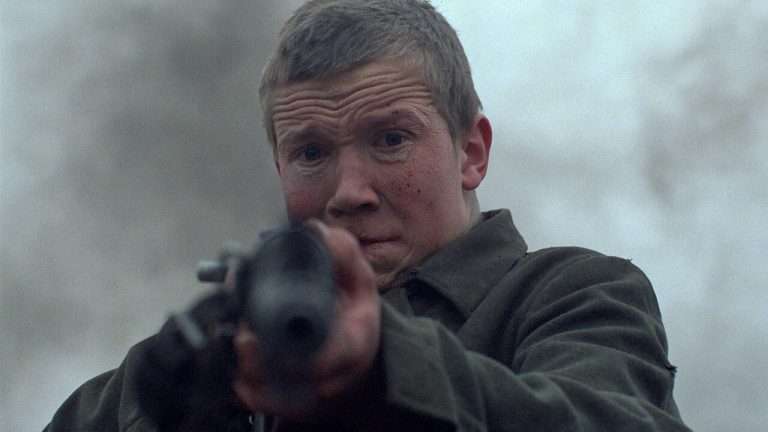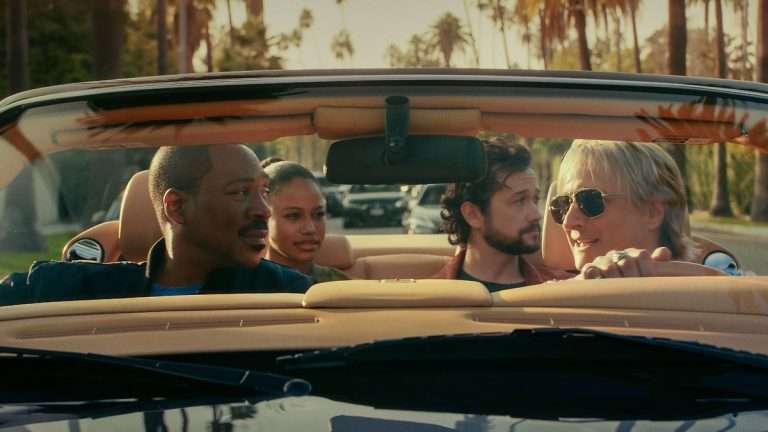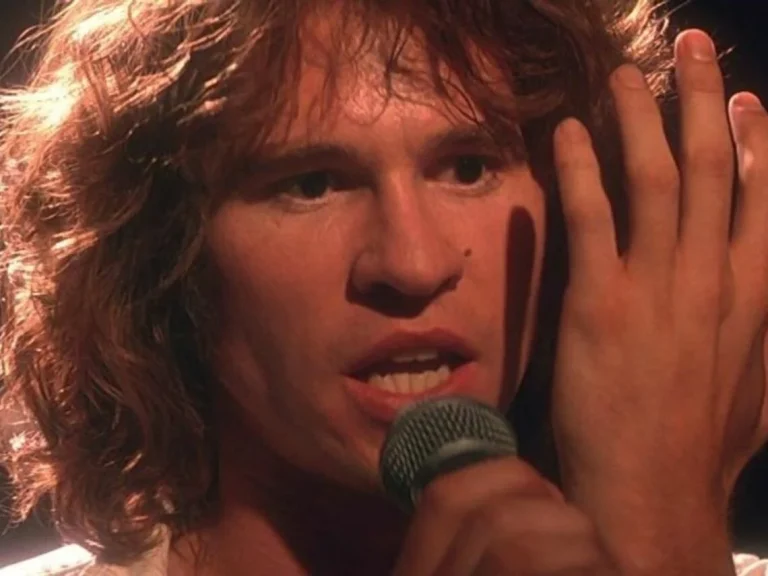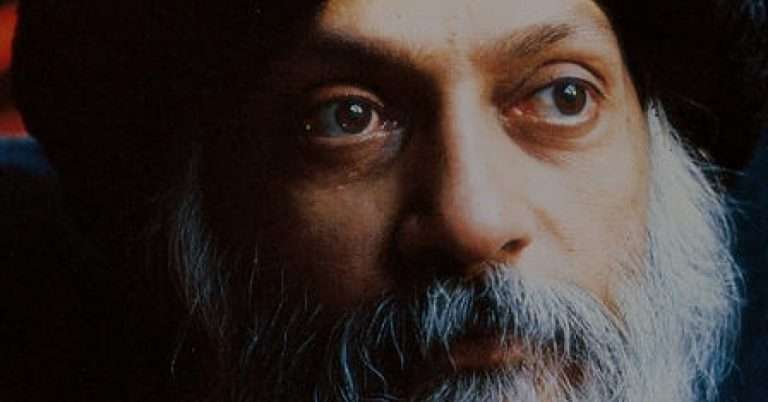Best Movies That End in Dance: There’s an art to ending things. Not every film can end with a dance, nor should they. There’s something about the sudden excess of physicality that absolutely has to be earned. The dance finale can either fall into the category of an overdone, irritable cliche or can be a moment where routine gives away to something grand and ecstatic. There are infinite variations and infinite interpretations of the musical finale. Sometimes, it’s beyond the established reality of the film, outside the bounds of the film’s space and time. Sometimes, it’s only a spectacle or a coda. In dance, you have transcendence and immanence. Life is held together only by actions, rhythms, and rituals of consensus–and there are few things as beautiful as the electric possibility of harmonious movement.
Here are 10 films that couldn’t refuse their characters and their viewers one last dance.
10. Another Round (2020), dir. Thomas Vinterberg (2020)
Films depicting alcohol consumption usually choose the well-trodden narrative path of the utter destructiveness of alcoholism. Thomas Vinterberg’s Another Round, however, remains a celebration of life. The film follows four colleagues who are disillusioned and disaffected by their lives, caught in a sedentary rut. The group then decided to experiment on maintaining a low alcohol content in their bloodstream by drinking at small intervals throughout the day.
Ultimately, the film is about re-discovering oneself and one’s dynamism and vigor in life. To re-find old passions and joys, to see a way forward that isn’t simply repeating yesterday’s routine out of habit. Nowhere is this more evident than in the gloriously exuberant and cathartic closing dance number. Martin (Mads Mikkelsen), a depressed teacher with wrecked home life, after much urging from his friends, recalls the jazz-ballet lessons of his youth and begins dancing. This final scene creates a sequence of joyful abandon while his friends and students look on in delight. He is no longer desperate or aimless. He is simply celebrating the moment of pure joy. Martin had been on autopilot, depressed and purposeless. This final dance is a recognition that his work and life have mattered; he breaks free from his old listless ways for his students. He recognizes joy and joins in.
9. Guardians of the Galaxy Vol. 3 (2023), dir.James Gunn
Guardians of the Galaxy Vol. 3 ends with a dance party to Florence + The Machine’s pop anthem Dog Days Are Over. The Guardians trilogy has always been about people who have hurt and are hurting coming together to build a family. The villains have been forgettable, and the plot is relatively unimportant. James Gunn’s priority has evidently been finding strength and power in responsibility. Always the reverse of Peter Parker’s maxim, the Guardians’ power has come from their bonds, acts of care, and kindness for each other and the broken people of the galaxy.
In this third and final volume, after enduring much pain and heartbreak, they are able to celebrate their victory together and dance. It’s a sincere but bittersweet moment. The Guardians are not a team anymore. They have found acceptance elsewhere. But that is ultimately cathartic and fitting for each character. They have each found their calling—whether it is fatherhood, finally becoming captain or finding the strength to go out into the world on their own. The dance also speaks volumes about the one person not included in the dance—Peter.
Peter Quill has been dancing away from his life and pain all along, and he finally chooses to face reality. His family, Rocket, Drax, and Nebula, who have soaked up struggle all their life, finally let go of it and dance like nobody’s watching. Rocket lets loose a defiant howl at the sky, more alive and animal than before. It’s a powerful ending and one last perfect song choice from James Gunn.
8. Jojo Rabbit (2019), dir. Taika Waititi
Taika Waititi’s 2019 comedy Jojo Rabbit has a strange premise: ten-year-old Hitler Youth Jojo’s imaginary friend is Adolf Hitler. Jojo finds out that his mother is hiding a young Jewish girl named Elsa in their attic and must come to terms with his beliefs. This very absurd setting lets Waititi cleverly present the utterly ridiculous ideology of Nazism and nationalism. The film portrays the last dwindling days of Nazi Germany, where children are taught lessons on how to recognize Jews using racist caricatures and are thrust into battle wearing only scraps and wielding outdated weapons. Their home becomes the frontline.
The ending seems bleak: Jojo has lost his mother. Elsa’s fiancé is long dead. They have lost years of their life to this vile and meaningless atrocity. And yet, with Hitler dead and the war over, they are finally free. They have both been dragged through hell and come out the other side, leaving behind their loved ones. They are alive. And to young children, what is freedom and life but dancing?
Dance is a recurring motif in the film, carrying undertones of love and freedom. Mid-film, Jojo asks Elsa what she’ll do when she’s free. Her reply is simple: dance. And it comes full circle with the beautiful ending, with Elsa and Jojo dancing away to David Bowie’s Helden. The choreography itself speaks to newfound freedom as their dithering gives way to shoulder bopping and quirky little steps, which finally grow into a joyful dance in the light of the new day.
7. Beau travail (1999), dir. Claire Denis
In Claire Denis’ Beau Travail, the movement of bodies, more than words, tells the story. Her camera captures and lingers over physicality without it feeling crude. The movements are shot in a dreamlike haze. Adjutant-chef Galoup of the French Foreign Legion is a disgraced soldier reflecting on his time in Djibouti, where he was in charge of troops, leading a strictly regimented life of a career soldier. When a new recruit named Gilles Sentain joins Galoup’s unit, he takes an immediate and irrational dislike towards Sentain. Galoup also admires his commanding officer, Forestier, and is envious of the affection he holds in the hearts of the soldiers. His jealousy and dislike drive him to greater bouts of irrationality, and he is eventually sent back to France, awaiting a court martial.
The film ends here, switching from Galoup’s simple, spare, and clean room to him alone in a nightclub. He stands before a mirrored wall, smoking a cigarette. He twirls and drops down to his knees. And then he flings himself free. It’s thrillingly choreographed and comes across as a startling choice as well. Only moments ago, Galoup was lying in bed with a gun. The dance comes as a release of tension: the tightly-wound Galoup with his clockwork movements suddenly so loose, so carefree? It’s almost as if he’s a new man in a new body. Is it a flashback? Is it a hallucinatory dream of a man about to kill himself? A deeply repressed fantasy? The ending dance sequence offers a moving conclusion. For much of the film, Galoup has moved like a tense predator. Finally, in this single sad, untethered moment, he is liberated.
6. Salò, or the 120 Days of Sodom (1975), dir. Pier Pasolini
A good ending recontextualizes the entire film. Salò’s ending recontextualizes in Italy’s history the previous 100 or so minutes of incessant display of violence and sadism. The commonly accepted themes of Pier Pasolini’s film are, among other things, the fascist subjugation of youth through degradation, political corruption, authoritarianism, etc. With its carefully constructed decadent mise en scène and voyeuristic lensing, its lush soundtrack framing some of the most depraved acts of sexual exploitation, violence, and humiliation ever put to film, Salò, more often than not, feels like an endurance test. It’s designed to shock, disgust, and repel viewers. And for the most part, the extremity of the violence feels gratuitous and pointless. Viewers are well aware of tales of the debauched wealthy. Aristocrats and politicians having depraved rape-torture-murder parties? There’s hardly anything surprising about that.
But the film’s ending clears up that confusion. In the film’s final shot, the two young soldiers who had taken part in the atrocities dance together while the victims are tortured and murdered outside the castle. They shake hands, they talk about their girlfriends, and they dance. The structure of the film is suddenly given a new meaning. Pasolini uses these atrocities to make a statement about fascism, but with the final dance, he holds up a mirror to the human race. The viewers have been participants in the torment as voyeurs.
As a cinematic rite of passage, viewers sit through hours of suffering and hatred. They become privy to the nuances of the characterizations. And with the final dance, the viewers are aware now of how mundane it is to some and how easily these boys will get away with it. Like Italian and German soldiers returning home after World War II, they will hang up their uniforms and return to their quotidian lives. Their girlfriends haven’t got an inkling of the atrocities they have taken part in. With that inevitably casual act of dancing, Salò lays bare the capacity and complicity in all of us to carry out these visions of terror.
Read More: The 10 Best French Musicals
5. Zorba the Greek (1964), dir. Michael Cacoyannis
The legacy of Zorba the Greek’s final sequence perhaps makes it the most influential film on the list. The Sirtaki dance, specifically choreographed for the film, is incredibly popular in Greece and accepted as a modern Greek folk dance popularly associated with the Greeks. Loosely episodic and meandering in its narrative construction, the film traces the multiple journeys of two friends—the exuberant peasant musician Zorba and a staid buttoned-up middle-class writer, Basil. Soon, the fragments of the narrative gain significance as metaphors for the spontaneity of human existence. Zorba exudes immense influence on Basil, encouraging him to break out of his rigid routines and give in to a little bit of madness.
The final dance sequence exemplifies Zorba’s campaign for a little bit of madness. After Basil has invested all his money and hope into Zorba’s madcap scheme and watched it collapse before his eyes, amid despair and hopelessness, the two begin to dance a spirited Sirtaki. Having followed these two characters – so different from one another – to see Basil defy rationality and join Zorba in his dance is a true encapsulation of the film’s philosophy. Disasters come, and disasters go. All we can do in its face is to throw worry to the wind and dance.
4. Rushmore (1998), dir. Wes Anderson
Rushmore starts as a fairly standard high school comedy. Max studies and struggles with his school life in his prep school. He excels in extracurriculars, not so much in academics. He falls in love with a new teacher, Rosemary. Moreover, he finds a mentor in Herman, attempts to woo the teacher, and inadvertently has to compete for her attention when she starts seeing said mentor—all in all, your everyday high school coming-of-age story. Soon, however, it becomes evident that—as with all Wes Anderson films—the characters are all equally messy, stunted, and emotionally immature. Whether it’s the teenage Max or the middle-aged Herman, they suffer equally.
The film’s poignant message is all about growth, change, and acceptance, and this progress comes together in its final few moments. Max has matured beyond self-hate; Rosemary has found the strength to move on; Herman has another chance at life. And they all come together to share a final dance. It really is one of the greatest endings put to film, both bittersweet and triumphant. The troubles are all there, and so are we. The dead cannot be brought to life. Wrongs cannot be righted, only atoned for. But it is possible to make peace and dance together.
3. RRR (2022), dir.S. S. Rajamouli
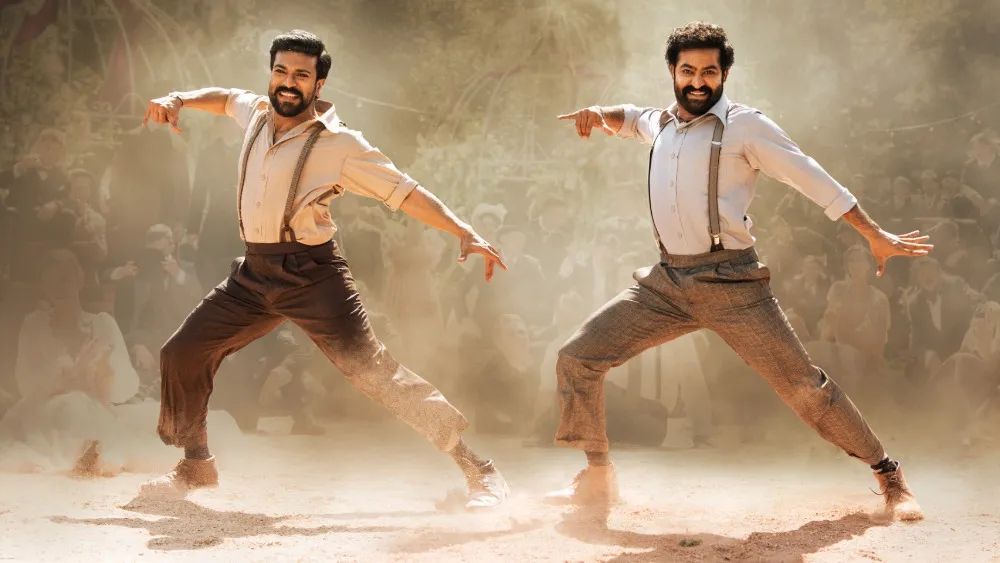
RRR is incredibly fun. Go-for-broke, hell-for-leather, adrenaline-choking-out-your-breath fun. It’s also perhaps one of the best action movies made, filled to the brim with evil white people in terrible and ahistorical period costumes, generous garnishing of homoerotic tension between the leads, an incredible dance-off, CGI tiger fights, even a love interest or two thrown in for some compulsory heterosexuality. This glorious and larger-than-life spirit is carried over to the film’s final few moments with a beautifully choreographed dance sequence.
It’s a celebratory song and dance number featuring the main cast and a cameo from director Rajamouli. Replete with symbols of Indian nationalism, including an early iteration of what would eventually be adapted into the national flag as we know it today, the dance is one final triumphal statement of anti-colonial resistance in the film’s universe. It’s also, perhaps, a final hammering down of the utter self-confidence and certainty of the film’s success on the part of the cast and crew, as Rajamouli has since revealed that during the film’s development, RRR stood for the main stars and the director (Ram Charan, Rama Rao, and Rajamouli himself).
2. Mother (2009), dir. Bong Joon-Ho
Like all of Bong Joon-Ho’s films, Mother is meticulously crafted, along with stellar performances from the entire cast and an ending that’s pure poetry. Much more grounded and melancholic than Parasite or Memories of Murder, Mother is ostensibly about a mother trying to prove her son’s innocence in a gruesome murder and demonstrate how powerful unconditional love can be. For all intents and purposes, the film is about that, just not the way we expect. Given the story’s circumstances, maternal love’s strength takes a terrifying edge.
Mother opens and closes with a dance sequence, both responding to each other. The opening titles accompany Kim Hye-ja’s lonely deadpan dance in a field. Between this absurd opening and the sublime conclusion is a tragic detective story that burrows deep into guilt, memory, maternal love, and its burdens. The film’s final moment is a claustrophobic dance, simultaneously a moment of liberation and rejection. She carries the burden of truth in her—the possibility of having raised someone monstrous, failing them until they fail others. She dances and lets go. Sometimes, a mystery is better left unanswered.
1. Paddington 2 (2017), dir. Paul King
Paddington 2 is by far the most delightful movie on this list. Unquestionably wholesome and perfect, the sequel to the 2014 film about a cute, fluffy, and talking bear is as open-hearted and kind as films get. Don’t balk at Paddington 2’s colorful and seemingly saccharine world. It’s a film with a clear and genuine political message for people of all ages and all sizes. Seriously, how many films directly aimed at children critique the prison industrial complex with such glorious flair? The film ends with Hugh Grant performing a musical number from Stephen Sondheim’s Follies. This brilliant final number performed by the newly reformed Buchanan for the prisoners’ entertainment drives home the point of prisoners being humans deserving of respect, luxury, and care just as much as those on the other side of the bars.
This is presented not as a cynical punchline but as a genuine truth. This scene is just pure joy: Hugh Grant + tap-dancing prisoners + Sondheim! Over and over in the film, kindness is presented as a radically transformative political force. Proudly against transactional relationships, people welcome strangers into their lives and are changed for the better. Compassion begets compassion, our dreams come true in strange and surprising ways, and there’s nothing better than basic human (or ursine) decency and some good toast and marmalade to set a stone heart beating.













